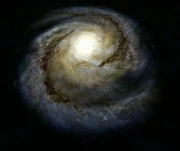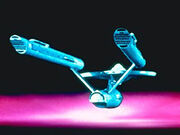KingElessar (talk | contribs) No edit summary |
(Echoes from the Past information) |
||
| Line 1: | Line 1: | ||
[[Image:Milky Way.jpg|thumb|The [[Milky Way Galaxy]] as depicted in the ''[[USS Voyager|USS Voyager]]'s'' [[Astrometrics Lab]] in [[2374]]]] |
[[Image:Milky Way.jpg|thumb|The [[Milky Way Galaxy]] as depicted in the ''[[USS Voyager|USS Voyager]]'s'' [[Astrometrics Lab]] in [[2374]]]] |
||
[[Image:Enterprise barrier.jpg|thumb|The [[USS Enterprise (NCC-1701)|USS ''Enterprise'']] approaching the [[galactic barrier]]]] |
[[Image:Enterprise barrier.jpg|thumb|The [[USS Enterprise (NCC-1701)|USS ''Enterprise'']] approaching the [[galactic barrier]]]] |
||
| − | The '''Milky Way''' is a spiral [[Galaxy]] in which most of recorded [[:Category:Timeline|history]] takes place. |
+ | The '''Milky Way''' is a spiral [[Galaxy]] in which most of recorded [[:Category:Timeline|history]] takes place. The name "The Milky Way" comes from [[Earth]]; the galaxy is also known as the "home galaxy." ({{g|TNG|Echoes from the Past}}) |
The Milky Way is approximately thirteen billion years old and 100,000 light-years across, 15,000 light-years deep at the galactic core and contains approximately 500,000 stars which orbit the galactic core over a period of around 220 million years. Somewhat unusually the Galaxy is enveloped in an energy field known as the [[galactic barrier]]. A similar field, the [[Great Barrier]] encloses much of the Galactic Core. Both fields were created by the [[Q Continuum]] to protect the Galaxy from a gang of powerful malicious beings ([[Star Trek: The Next Generation|TNG]] [[Miniseries]]: ''[[The Q Continuum]]''). |
The Milky Way is approximately thirteen billion years old and 100,000 light-years across, 15,000 light-years deep at the galactic core and contains approximately 500,000 stars which orbit the galactic core over a period of around 220 million years. Somewhat unusually the Galaxy is enveloped in an energy field known as the [[galactic barrier]]. A similar field, the [[Great Barrier]] encloses much of the Galactic Core. Both fields were created by the [[Q Continuum]] to protect the Galaxy from a gang of powerful malicious beings ([[Star Trek: The Next Generation|TNG]] [[Miniseries]]: ''[[The Q Continuum]]''). |
||
Revision as of 21:45, 7 September 2009

The Milky Way Galaxy as depicted in the USS Voyager's Astrometrics Lab in 2374

The USS Enterprise approaching the galactic barrier
The Milky Way is a spiral Galaxy in which most of recorded history takes place. The name "The Milky Way" comes from Earth; the galaxy is also known as the "home galaxy." (TNG video game: Echoes from the Past)
The Milky Way is approximately thirteen billion years old and 100,000 light-years across, 15,000 light-years deep at the galactic core and contains approximately 500,000 stars which orbit the galactic core over a period of around 220 million years. Somewhat unusually the Galaxy is enveloped in an energy field known as the galactic barrier. A similar field, the Great Barrier encloses much of the Galactic Core. Both fields were created by the Q Continuum to protect the Galaxy from a gang of powerful malicious beings (TNG Miniseries: The Q Continuum).
In addition to the main body of the Milky Way the Galaxy has a number of smaller companion bodies most notably the smaller and larger Magellanic Clouds. The Galaxy is also in the process of absorbing a dwarf Galaxy SagDEG. The Milky Ways' nearest neighbour is the Andromeda Galaxy some 2.2 million light years away.
The Galaxy is naturally subdivided into a number of arms, with the Federation and its neighbours mostly occupying the Orion Arm. However for the sake of standardised navigation the Federation and most other galactic powers divide the Galaxy into four equal segments; the Quadrants.
Given the huge size of the Galaxy and the limited velocities available at Warp speed a number of races use networks subspace pathways to navigate the galaxy. Some are natural such as those formally controlled by the Vaadwaur where as others are artificial constructs such as the Borg Transwarp, Iconian Gateway and the Caeliar Subspace Tunnel networks or the Bajoran wormhole.
Galactic arms
(radiating from the center clockwise)
- 3 KPC Arm (the Shapley Center)
- Norma Arm
- Crux Arm
- Carina Arm
- Orion Arm
- Perseus Arm
- Outer Arm
- Scutum Arm
- Sagittarius Arm
Galactic quadrants
External Links
- Milky Way Galaxy article at Memory Alpha, the wiki for canon Star Trek.
- Milky Way article at Wikipedia, the free encyclopedia.
